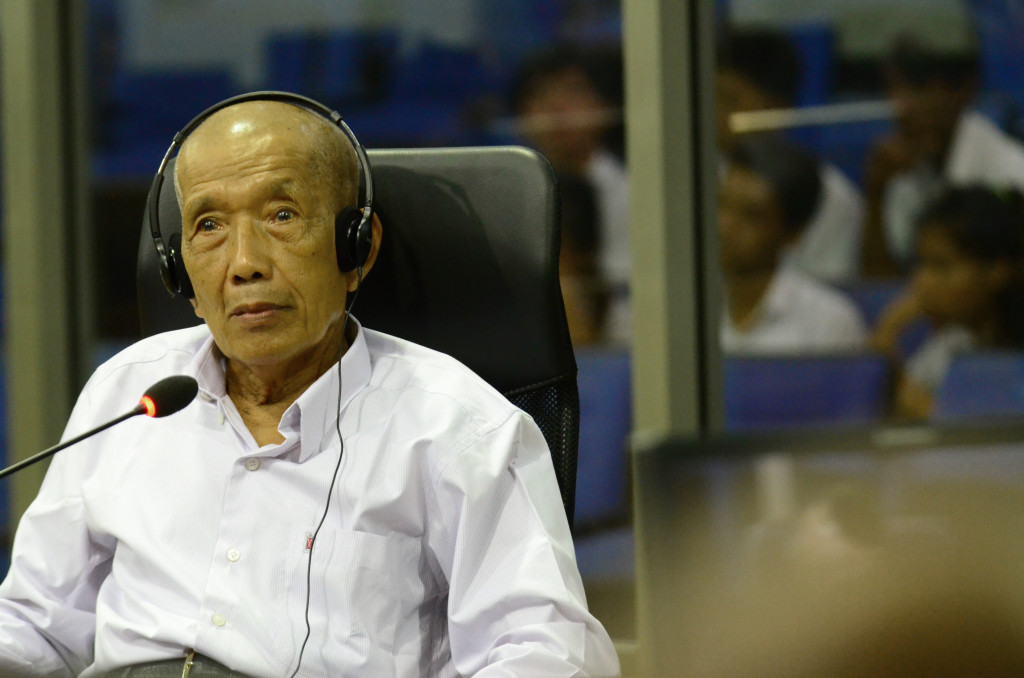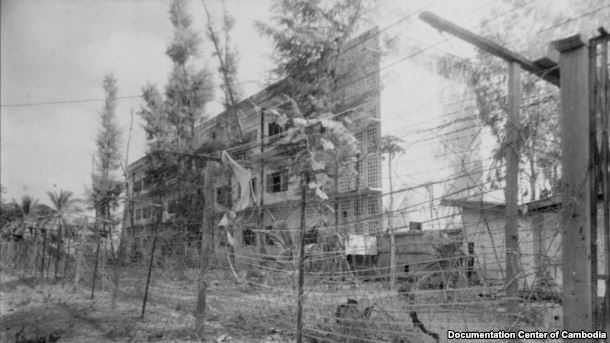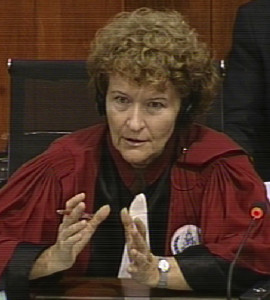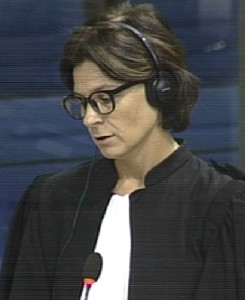War Criminal Duch Recounts S-21 Methods of Torture and Burning Bodies of Westerners
Today, Senior Assistant Prosecutor Dale Lysak held a tight grip on his line of inquiry about the modus operandi of S-21 interrogations, and dealt extensively with the methods of torture that were used. Marie Guiraud, Civil Party Lead Co-Lawyer, was granted the floor in the afternoon. Ms. Guiraud made of point of telling the witness, Duch, about the victims who had joined the Civil Party proceedings and why. Throughout all of her exchanges with Duch, her mind was set on sexual assault and rape at S-21, much like her questioning of Suos Thy last week. Though she exerted to ask very specific questions relating to particular accusations, Ms. Guiraud fell short of time.
Physical torture at S-21: Duch felt “pity”
Perhaps not as attentive as the previous days but still very open to answering questions, Duch was first grilled by Mr. Lysak regarding interrogations at S-21. After he said he did not know about the exact count of prisoners at S-21, the witness explained that the length of an interview could vary: “if they were willing to confess, their interrogation was shorter.”
Though acknowledging that he had testified extensively about this in the past, including yesterday, Mr. Lysak had the witness describe out loud the methods of torture that were used at S-21 (“cold”, “hot”, and “chewing”)[1]. Referring back to one of his earlier statements, Mr. Lysak pulled out this quote[2]:
“There were four types of torture used under Son Sen’s orders: beating with a stick, electroshocks, covering the head with a plastic bag to suffocate, covering the mouth and face with a towel, or a krama, and then pouring cold water on the towel [also known as waterboarding]. The one that was used the most was beating with a stick, because the others were time-wasting.”
He added that important prisoners could not be beaten, or interrogators would be punished. The Prosecution then confronted Duch with two confessions of S-21 prisoners. Duch specified that he recognized Son Sen’s handwriting on several comments, though reports detailing confessions were sent to the upper echelon more generally[3]. Duch also recognized his own handwriting on a few documents[4]. Mr. Lysak always made sure he said the full names of prisoners the document excerpts, and systematically read out quotes.
“When we started torturing, he started confessing”.
Instruments of torture
Mr. Lysak asked the witness what types of instruments S-21 interrogators used to torture the prisoners. Trying to show there was some sort of protocol, Duch described how interrogators were not to use military batons or excessive strength, as it harmed the prisoners more, even leading to death of some of them. Interrogators had to find beating sticks on their own. Some instruments were only used to threaten prisoners but were not actually used on them.
Duch firmly denied that the prisoners’ screams could be heard outside the prison, though several sources showed otherwise[5].
Duch went on and confirmed the names of several cadres involved in producing reports (Saem Hoeung, or Hun[6]) and teaching him torture methods to instruct his subordinates (Deputy Prime Minister Vorn Vet and Yun). The witness mentioned the way prisoners were choked with plastic bags, illustrating his words by putting his hands to his throat. He recalled Vorn Vet saying:[7]
“You have to look at the pulse on the neck: if it pulsed very strongly, they were spies”.
Another document signed by someone whose handwriting the witness could not recognize accounted for another method of beating prisoners: electrical wires were tied together and used to beat them, as opposed to the usual tree branches[8]. Ta Nat, who was chairman of S-21 before Duch took over, favored electric shocks over other methods of torture. As he had done several times before, the witness started speculating after he said he did not know – this time, he was interrupted by Judge Claudia Fenz: “Don’t guess. If you don’t know, don’t guess”.
As to Duch’s own involvement in the torture methods, he said that he had never participated. He however knew specific details about it: for example, that electric wires were attached to the prisoner’s toe, which “he had heard from others”. The witness didn’t deny he had recommended torture after some prisoners did not confess[9], even though Pon and Poa among others were the ones who carried out the orders. The witness depicted grim examples of torture, even referring to one as having been “partially tortured”[10].
Disturbing reminders of psychological torture
“I had him put his palms together to salute the wall, the electric wire, the whip […]. I showed him a picture of a dog with a human head which I told him to salute it as well.”
This quote illustrated what methods were used on prisoners when they were interrogated at S-21[11]. Duch did not know about this image, but previous findings of the Court (Case 001, Trial Judgement 2010, para: 241) had shed light on this image as used in interrogation techniques: prisoners had to pray to the image of a dog with the head of Ho Chi Minh, former Communist leader in Vietnam from 1945 to 1969[12].
Another tactic used by the interrogators was to put “political pressure” as well as emotional pressure on prisoners, appealing to their feelings by mentioning their families[13] [14]. These interrogation methods proved efficient in several reports[15].
Whether confessions were true or not mattered very little, Duch says
The witness firmly denied that Nuon Chea deemed that some interviews conducted under torture could not be used and accordingly recommended to Duch that these prisoners were to be released [16].
“Mr. Witness, did Nuon Chea ever instruct you to stop torturing them?
No.
Did he ever instruct you to release prisoners?
No. No prisoner was ever released.”
The witness elaborated by saying Pon was the only instance of this type of instruction, as he was kept to work on the compound of S-21. Duch explained he was not fond of using torture to obtain evidence because the veracity was difficult to verify, but he was instructed to continue by Nuon Chea[17]. He also explained that he was the one who taught interrogators the questioning techniques. According to one of his colleagues named Tun, who quoted Pol Pot: “third confession’s a charm”.
The interrogation by the Senior Assistant Prosecutor ended by making reference to a previous testimony by Duch, who answered that all the decisional power was in the hands of the center of the party[18]:
“[Pol Pot] used the words “C.I.A”, “K.G.B”, “agents of the land-grabbing Yuon” [referring to the Vietnamese] without distinction, in order to smash people who were in his way. It was just a placard that they raised to smash people. They did not think about if the confessions were true or not; they smashed anything that blocked their path.”
Marie Guiraud, ringed by the families of S-21 victims
Civil Party Lead Co-Lawyer Marie Guiraud spoke slowly and paused at strategic times, choosing her words so that not only Duch, but the whole courtroom, could comprehend what the victims who lost their families were going through. She indicated that 61 new Civil Parties joined the proceedings since he was last in Court, amounting to more than 150 in total.
Among the victims she mentioned, Ms. Guiraud spent more time on Chao Seng, who was the head of the pedagogic institute. Chao Seng’s brother, Chao Kum, had joined the Civil Party proceedings[19]:
“The death of my older brother, Chao Seng, gives me deep sorrow; he was like a father to me […]. I file a complaint to the tribunal in the hope of discovering the truth and obtaining justice for my brother.”
Remembering the name Chao Seng, the witness pointed he had previously said that he wanted to see his wife to “express his regrets that [he] could not protect him. Chao Seng did many great things.” Under the orders of Son Sen, he had written the name “Chao Sun” in the S-21 records in order to keep his identity secret.
“Nuon Chea had known that I had tried to protect Chao Seng, which is why he ordered his execution.”[20]
Duch said he had used Chao Seng to interrogate Vietnamese prisoners together with Mam Nai, but was instructed by the upper echelon to “smash him”. Chao Seng was sent to S-21 in August 1977 and was first “kept alive” by Son Sen. This changed when Son Sen left to the battlefield and Nuon Chea took over his position.
Ms. Guiraud said she would move on and take another example. She paused a few times, letting the name Ros Sarin, former head of Pochentong Airport, sink in. The witness had never heard of him. He and his wife, who filed a civil party complaint as well, were detained at Boeung Trabey (or Trabek), where Ros Sarin disappeared[21] [22]. Ms. Sarin later found out he had been sent to S-21. The witness confirmed that many people were sent from Boeung Trabey to S-21, though he only knew about it when they arrived. Ta Boeung Trabey had two facilities, one directed by Ouk Savorn and one for intellectuals controlled by Pong. He could remember a professor called Phoeung Tong, who was detained at Boeung Trabey. Ta Nat had told him about Tong’s presence at the prison.
Duch understood Ms. Guiraud in French. When she took the floor, he pivoted his chair so as to be facing her while he answered her questions. Later, President of the Court Nil Nonn asked for Duch to sit facing the judges instead.
Westerners far from home, detained at S-21
Ms. Guiraud then proceeded to question the witness on the two Americans incarcerated at S-21[23]. The brother of Michael Scott Deeds joined the Civil Party proceedings[24]. Inquiring what Duch remembered about them, he answered:
“They trespassed on the territory of Kampuchea in order to obtain information. […] They were interrogated and then smashed. They were burnt in a fire lit by tyres.”
He went on and said that the four Westerners were killed and burnt under the orders of Nuon Chea, at a location where Vorn Vet, Hor and Nath were also killed[25]. He then explained what Brother Nuon had told him:
“[Nuon Chea] summoned me at Samrawit Buddhist school and told me that the people with the long noses [the Westerners] had been smashed and now had to be burnt, reduced to ashes; we couldn’t do like Cuba and keep U.S. prisoners to exchange them for tractors, he said, we have to reduce them to ashes.”
“We had to reduce them to ashes so there would be no proof that we had arrested and smashed Westerners.”
Ms. Guiraud then attempted to ask the same question she asked Suos Thy last week, hoping for a more conclusive answer by Duch: “Was there a system of collecting and transportation of human feces at S-21 (prisoners and staff) and if yes, where were they taken?”. Duch however did not know anything about it.
Rape and sexual assault at S-21
Ms. Guiraud intended to cover as many testimonies related to rape as possible, but was limited by time. She had already tackled some of these cases last week with witness Suos Thy, former list-keeper at S-21[26]. The alleged rape of a prisoner by a medic called Soeung was backed by the testimony of Lach Mean from earlier this year, but the witness denied he knew anything about it.[27] “I only know of one case of sexual assault at S-21: a young man sexually assaulted my former professor, in the context of an interrogation. I think there weren’t many cases of rape at S-21.”, he said.
In the same testimony, Lach Mean reported on an incident during which a guard raped a prisoner in a staircase, but Duch questioned the credibility of this witness.
“I don’t think it was so easy to rape a woman in front of everyone – the person who did that would risk decapitation. I have a hard time believing this.”
Duch said that he suspected Lach Mean to have told this story in order to incriminate him.
Him Huy, former S-21 guard who worked under the supervision of Peng, gave a testimony that was also supporting evidence that there had been several instances of rapes of prisoners by prison guards[28]. Duch’s only reaction to this statement was that such incidents would have been reported to Hor, not him: “I do not wish to make any further comment to that”.
The witness was more categorical when Ms. Guiraud started talking about rape allegations against Chhum Phal, chief of the security guard group along with Peng[29]. “I heard of this incident, but he was innocent”, Duch hammered.
“Mr. Witness, how do you know this did not happen?”
“Who would have dared to engage in any sexual rape at S-21? There were several armed guards on the compound. No one would have dared.”
He declared that he did not acknowledge the detention of the alleged victim at S-21.
Ms. Guiraud pointed out that the victim Nam Moeun was deemed credible by the Office of the Co-Investigating Judges and was a direct victim in the Civil Party suit. She then moved headway and tackled another case about an S-21 interrogator named Tuch, whom the witness knew about:
“I know that he was a difficult person to complete a task and he likes to inflict torture upon prisoners in order to compete with Pon.”
Duch seemed confused as to different individuals who had similar names – he did not know the one who had been arrested at S-21[30], “combatant of interrogation at S-21” on the list. Pressed by time, Ms. Guiraud asked “You didn’t necessarily know all the staff at S-21, correct?”, which the witness admitted: he explained that there were more than 1,000 staff members at S-21.
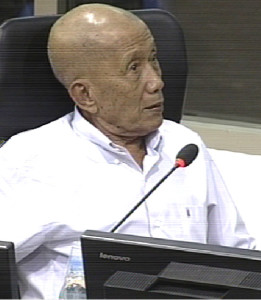 Another testimony, this time by Prak Khan, incriminated a guard named Tuoy, who worked closely with Chan and had raped a prisoner behind his house after interrogating her[31]. He was then imprisoned after he tried to escape. The witness was not being responsive to the plethora of evidence that Ms. Guiraud presented to him, only insisting that according to the chain of command, Son Sen or Nuon Chea would order the arrests. Reports went to Hor, who reported to him, and then he took it up to his two superiors. Any arrests had to be decided upon by the upper echelon, Duch said: “Only [the] upper echelon had the authority to decide on arrests”. However, Ta Nath had arrested “more than ten individuals” without approval from the upper echelon. He explained that upper echelon first referred to Son Sen, and later to “Brother Nuon”.
Another testimony, this time by Prak Khan, incriminated a guard named Tuoy, who worked closely with Chan and had raped a prisoner behind his house after interrogating her[31]. He was then imprisoned after he tried to escape. The witness was not being responsive to the plethora of evidence that Ms. Guiraud presented to him, only insisting that according to the chain of command, Son Sen or Nuon Chea would order the arrests. Reports went to Hor, who reported to him, and then he took it up to his two superiors. Any arrests had to be decided upon by the upper echelon, Duch said: “Only [the] upper echelon had the authority to decide on arrests”. However, Ta Nath had arrested “more than ten individuals” without approval from the upper echelon. He explained that upper echelon first referred to Son Sen, and later to “Brother Nuon”.
Duch’s lengthy answers provided substantial material and confirmation on many issues today. However, Civil Party Co-Lawyer Marie Guiraud was not able to delve into all the cases she wanted, notably the only one that the witness said he had knowledge of. The hearing will resume Monday, June 13th , at 9 am, with additional questions by Senior Assistant Co-Prosecutor Dale Lysak.
[1] Interrogators would start with cold methods to obtain biographical information from the prisoners; the aggressive, or “hot”, method was torture; the chewing method was for “stubborn” prisoners and involved further questioning.
[2] E3/454, 00146662 (KH), 00147604 (EN), 00149925 (FR).
[3] E3/1869, at 0017252 (KH), 00837417 (EN), 007769833 (FR).
E3/1894, at 00005360 (KH), 00702085 (EN), 00747302 (FR).
E3/38, at 00398164, 00398157 (EN).
E3/8368, at 00007470-71 (KH), 00278759-760 (FR), 00225395 (EN).
[4] E3/7426, at 0017200772 (KH).
[5] David Chandler, “Voices from S-21”: E3/1684, 00191985 (KH), 00357403 (FR), 00192822 (EN).
E3/834, 0077493 (KH), 00184508 (EN).
[6] E3/2475, at 00305504 (KH), 00836681-82 (EN), 00938432 (FR).
[7] E1/50.1, 19/03/2012 at 15h40.
[8] E3/3847, 00173829-830 (KH), 00223916 (EN), 00271475 (FR), §2.4.
[9] E3/3841, at 00172792 (KH), 00234676 and 223142 (EN), 00296037 (FR): “not confessed yet! Use torture” written by Duch.
[10] E3/1874, at 00084038 (KH), 00821432 (EN), 00819737 (FR).
[11] E3/3844, at 00173598 (KH), 00820962 (EN), 00869389 (FR).
[12] Vaen Kheuan’s summary of his interrogation of prisoner Oum Chhan, cited in
David Chandler, “The Voices of S-21: Terror and History in Pol Pot’s Secret Prison”
Alexander Laban Hinton, “Why Did They Kill?: Cambodia in the Shadow of Genocide”.
[13] 00007465-66 (KH), 00225392 (EN), 00278756-57 (FR).
[14] E3/1544, handwritten letter from Pon to Duch. Response: “Duch: Ya’s wife was very young, so when he was brought in, he was to be reminded of the welfare of his wife and children. Lysak: Was this a tactic to pressure him to give a confession? Duch: Yes.”
[15] E3/7437, at 00173742-743 (KH), 00780892 (EN), 00800851 (FR). July 1978 “I told him to prostrate himself in front of the image of the two dogs, and though at first he didn’t want to, he gave in after several beatings. I electrocuted him and talked about politics to confuse him. He then confessed to being CIA.”
[16] E3/4202, at 00858358-359, 00757537, 00849448 (FR).
[17] E3/1560, at 00320788-89 (KH), 00327327 (EN), 00327330 (FR).
[18] 00160908 (KH), 00160953 (FR).
[19] E3/4733, at 00794416 (FR), 00490618 (EN), 00478780 (KH).
[20] E3/1552, 15h31.
[21] E3/5040. Prosecutor list N7794.
[22] E3/9853.
[23] E3/1553, at 00088752 (KH), 01187845 (FR), 01236389 (EN). n12720 OCIJ list.
[24] E3/472.
[25] E3/1570, at 00154209 (FR), 00154194 (EN), 00154224 (KH).
[26] See Shedding Light on Lists of S-21 Prisoners: the Facts Between the Lines, The Cambodia Tribunal Monitor, June 3, 2016
[27] Lach Mean, testimony 26/04/2016, 11h05”14: Question by Judge Claudia Fenz: “did you know about incidents during which a guard or interrogator had sexually assaulted a prisoner and was then punished? Nurse Soeun, accused of moral misconducted with a prisoner was punished. You were the witness of two incident of sexual assault? There were initially two cases, and added to those there was the case of the nurse”.
See also S-21 Interrogator Testifies About Physical Mistreatment of Prisoners, The Cambodia Tribunal Monitor, April 26, 2016
[28] Him Huy testimony. 4/05/2016, 14h34”43 and 14h38”08: “at S-21, a staff member was arrested and detained but the guard was able to escape and fled to Vietnam”.
See also “Prisoners did not have any rights”, Witness Him Huy Says, The Cambodia Tribunal Monitor, May 4, 2016.
[29] E3/5602, PV, §458. Na Mon is the victim who joined the civil party suit.
[30] E3/10460, at 01160160 (KH) (list of prisoners entered 3/3/1977). Entry n14.
[31] E3/7463, transcript from case 001, 15h53”50.
Featured image: Duch, by S-21 survivor and artist Vann Nath, used on the cover of Getting Away with Genocide? Elusive Justice and the Khmer Rouge Tribunal, by Helen Jarvis and Tom Fawthrop, 2011

